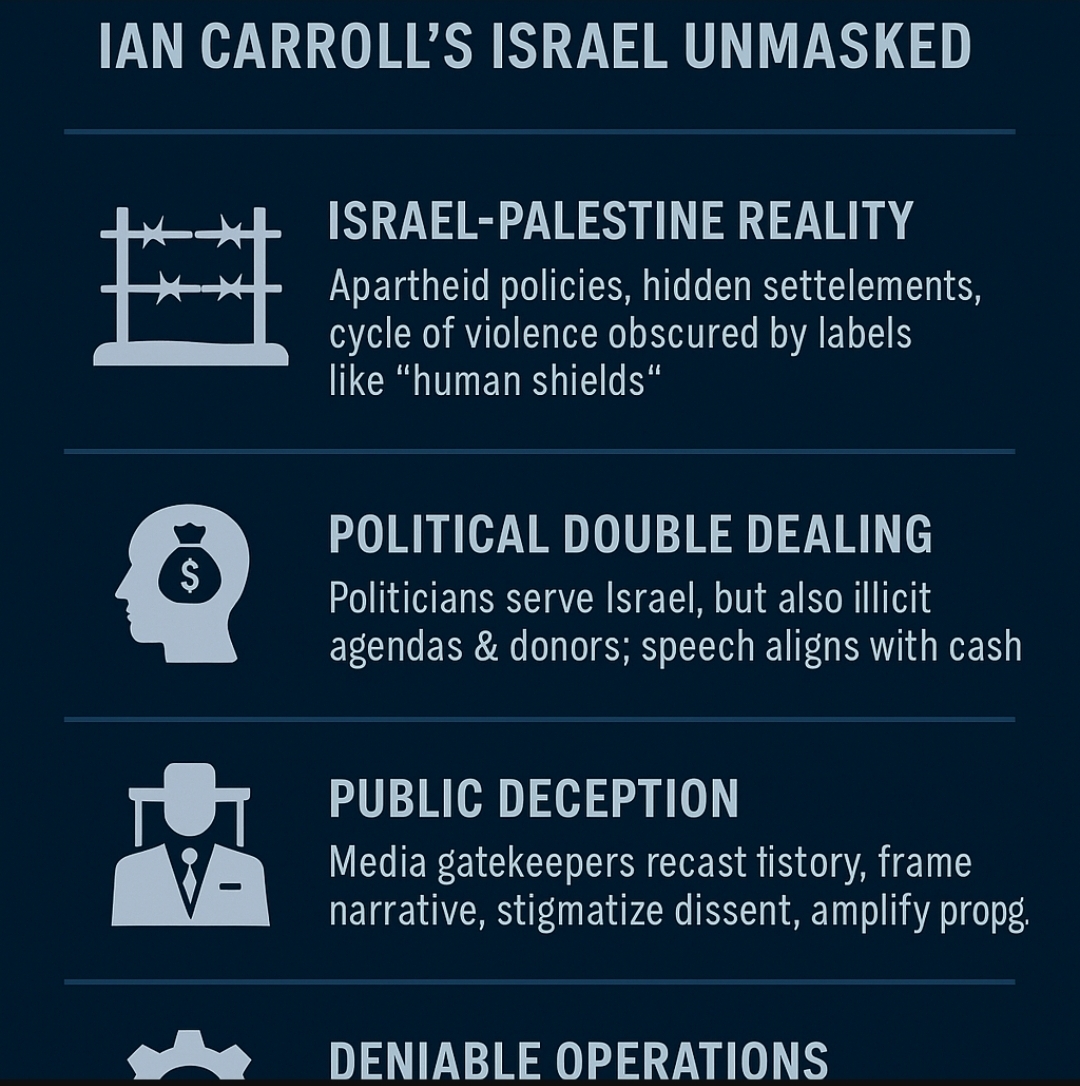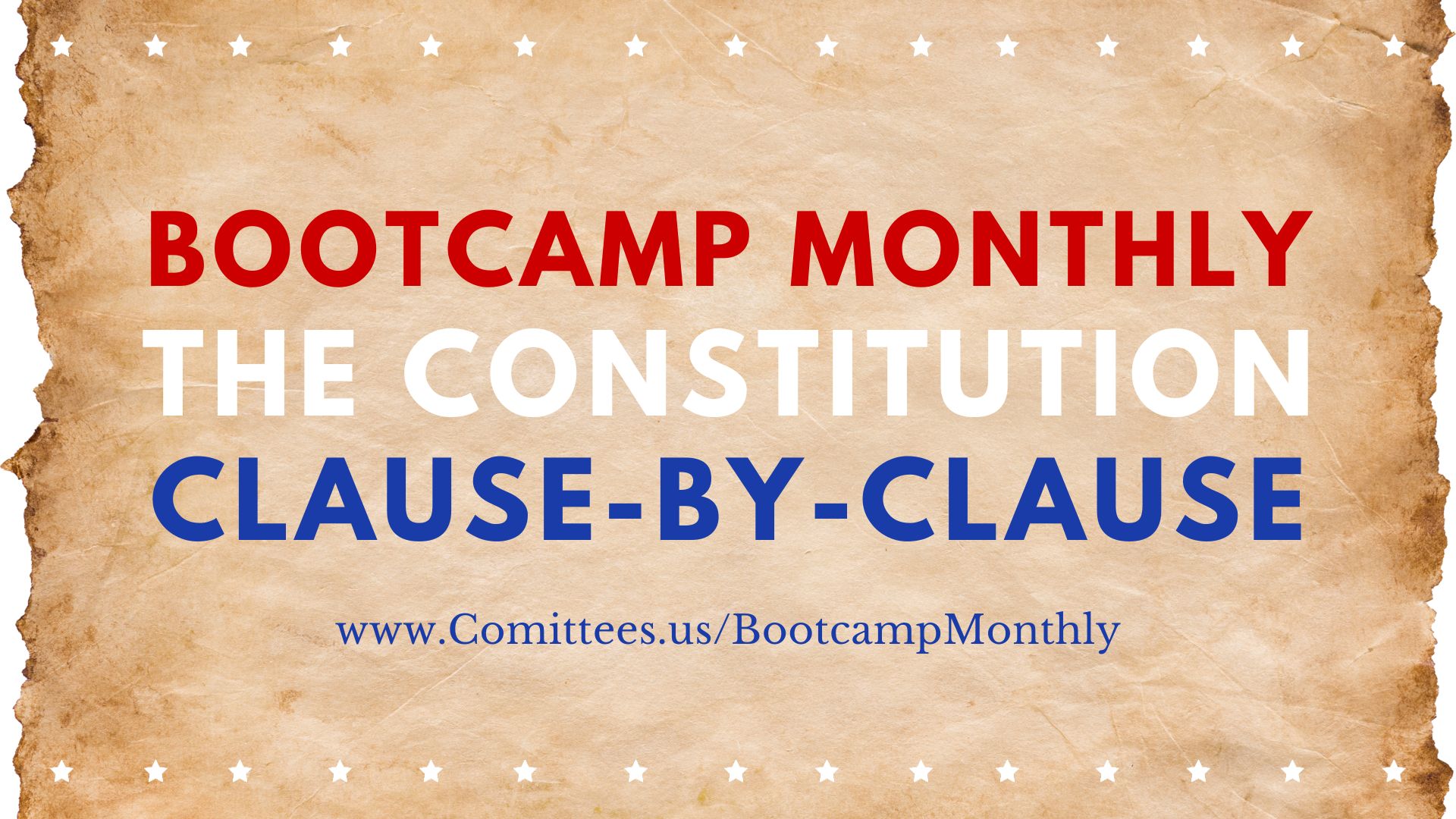“Creating Israel”
Set-up: One crack shatters the facade
Carroll frames the film as a wake-up call. Most citizens, he says, live under layered propaganda; once you spot a single seam, the whole story of the 20th–21st centuries start to reassemble. If you can spot one seam in the official story, the wallpaper peels off the whole century. Most people move through a managed reality—layered propaganda, curated scandals, patriotic rituals—that keeps attention on elections while the real operating system runs above them. He argues that once a viewer recognizes a recurring pattern—organized crime, intelligence services, blackmail, and media working in tandem—separate headlines begin to snap into a single picture.
This isn’t a theory about a few bad actors; it’s a mechanism. Prohibition teaches the state to hire crooks as cutouts. Cold War covert ops perfect plausible deniability. Sexual kompromat becomes cheaper and more durable than bribes. Media narratives (what he calls modern “information war”) normalize all of it. What looks like chaos, he claims, is actually continuity: the same incentives and overlapping networks reappear in new costumes each decade.
“What if I told you Iran had the bomb and a global blackmail ring… psych, it’s Israel.” Carroll cuts from rum-running docks to wartime port “security,” from early Zionist militias to modern counter-terror doctrine, from Hoover to Epstein flight logs, from Cold War Italy to post-9/11 think-tank memos.
“Democracy” is the storefront, deniability the product. Elected leaders come and go; the back office stays the same: spooks subcontract to criminals; criminals launder through legitimate culture; media helps staple a moral narrative (“for safety,” “for the children,” “for freedom”) over the logistics. When the stakes rise—wars, nuclear programs, foreign policy pivots—the same template scales up. Israel is not a lone puppet master, but as a central case study in how a young state learned, adopted, and then excelled at this operating system—nuclear opacity as leverage, hasbara as narrative doctrine, intelligence partnerships as force multipliers.
Stop treating the last hundred years as a string of accidents. Why did Prohibition birth national cartels and then “coincidentally” converge with port security in WWII? Why did early paramilitary tactics in Mandate Palestine “coincidentally” rhyme with later counter-insurgency? Why does a sex-blackmail scandal in our time “coincidentally” graze financiers, politicians, and intelligence alumni? The coincidences pile up because the method endures.
It’s a wake-up call about human costs: civilians under bombs, trafficked minors, entire publics marched by narrative into wars they barely understand. The line between “national security” and “protection racket” collapses when secrets, subsidies, and stories all point in the same direction—and when anyone who questions the arrangement is branded a crank, a bigot, or a traitor.
Don’t take his word for it—follow the pattern. If even one of those moves looks familiar, keep pulling the thread. The first crack is all it takes; the façade isn’t built to withstand sustained scrutiny.
1) Prohibition as the seedbed of a global network
The U.S. didn’t just get speakeasies and gang shoot-outs from Prohibition—it got an industrial upgrade to crime. Street crews professionalized into national syndicates, learned to launder at scale, and built “respectable” fronts in casinos, music, and Hollywood. World War II then taught Washington a fateful lesson: criminals make useful cutouts—partners you can use and deny.
From speakeasies to supply chains
Booze bans forced gangs to think like corporations. They hired chemists to doctor liquor, accountants to move cash, lawyers to buffer risk. They bought trucks, warehouses, and cops. What began as neighborhood hustles became interstate logistics with price sheets, bribe budgets, and written rules. This was the moment criminal networks learned to scale—and to look legitimate while doing it.
Crews become a “board of directors”
In the late-1920s/’30s consolidation—famously symbolized by syndicate “conferences”—as the shift from brawling ethnic crews (Italian, Jewish, Irish) to a cartel with territories and arbitration. Violence became “policy,” not impulse; disputes were “regulated” to protect the revenue stream. It is like a corporate roll-up, complete with regional divisions and a code of omertà.
Laundering through glamour (casinos, music, Hollywood)
The next move was legitimacy laundering. Nightclubs and record labels helped wash cash. Film and stage unions became choke points you could influence. Casinos—first in places like Havana and later Las Vegas—turned black-market fortunes into clean profits under bright lights. The effect, wasn’t just money laundering; it was culture laundering: the racket wrapped in tuxedos and neon.
The wartime handshake: criminals as cutouts
To secure East Coast docks from sabotage, U.S. naval intelligence worked through mob intermediaries on the waterfront and sought Sicilian contacts before the Allied invasion. Once Washington learned it could route sensitive jobs through criminals—getting help and plausible deniability in one go—the template stuck. Hire people you can disown if caught.
The lesson Washington kept
“Operation Underworld” (dock security via mob channels) didn’t stay in the 1940s. It became a method: subcontract the dirtiest work to people already outside the law. If it blows up, it’s “just gangsters.” If it succeeds, you chalk it up to patriotic ingenuity and move on. This method travels effortlessly into the Cold War—covert funds, foreign elections, arms deals—because the cutout principle works the same way at home and abroad.
Export model: from rum-running to geopolitics
By the 1950s–60s, the lines between syndicate interests and state interests crossed repeatedly—Cuba operations, casino politics, and later covert action that tapped criminal networks for deniable tasks. Whether each alleged tie was deep or glancing, he says the pattern matters: once the state sees criminal distribution and intimidation as tools, the overlap between crime and statecraft is no longer a bug; it’s a feature.
Why it matters in his narrative
This is the root system. Prohibition, industrialized crime; wartime deals normalized working with it. Out of that soil grows everything else: sex-blackmail as a managerial tool, intelligence outsourcing to “friends of friends,” and media smoothing the story for public consumption. If you accept this seedbed, the later branches—covert alliances, narrative warfare, and deniable force—look less like conspiracy and more like organizational continuity.
2) Blackmail beats bribes
Cash buys a vote once; kompromat rents a person forever. From small-town sheriffs to national figures, sexual leverage—recorded and retrievable—proved more reliable than envelopes of money. This craft professionalized over decades and culminated in the Epstein saga, not as a freak outlier but as the polished product of a system.
Why kompromat outperforms cash
- Recurring leverage vs. one-off payment: A bribe must be renewed; a secret renews itself. Fear of exposure keeps targets compliant without repeated transactions.
- Self-policing: The target censors themselves. No memos, no orders—just “prudence” that reliably aligns with the handler’s interests.
- Plausible deniability: If a policy choice later looks fishy, there’s no money trail—only private pressures no court can subpoena without luck.
The “supply chain” of kompromat
- Talent & targeting: Nightlife, modeling, charity galas, and donor circuits provide introductions and social cover.
- Setting the scene: Private apartments, islands, or hotels with controlled staff and prepositioned cameras.
- Recording & retention: Standardized capture protocols—multiple angles, off-site backups, and trusted couriers.
- Curation: Files indexed by name, fetish, date, and potential policy value; lawyers and fixers serve as gatekeepers.
- Gradual squeeze: The first “ask” is small (a meeting, a quote, a delay), building toward votes, contracts, or investigations quietly shelved.
The connection to earlier eras: Prohibition-era clubs and later casinos taught gangs to control rooms, staff, and stories. Those skills crossed into political society as elites and criminals mingled in the same curated spaces.
From county courthouse to Capitol
- Local: A sheriff or zoning chair gets compromised; outcomes shift on permits, raids, and prosecutions.
- Statehouse: Committee chairs and AGs become choke points for licensing, investigations, settlements.
- Federal: Staffers and donors act as relays, translating pressure into markup changes, hearing calendars, and agency guidance.
Epstein as “capstone”
Jeffrey Epstein is the institutionalized version of century-old methods: a hub that blended wealth management, celebrity, science philanthropy, and controlled environments suitable for recording. Epstein blackmail operation fit an established template—luxury, access, deniability—those powerful interests found useful.
How secrets steer policy without orders
- Soft vetoes: A bill never gets calendar time; a subpoena quietly expires.
- Agenda setting: Hearings focus on safe topics; witnesses with the “wrong” facts don’t get invites.
- Personnel: Nominations stall; “problem” investigators are reassigned; a compliant deputy is elevated.
- Narrative management: Friendly surrogates shape coverage; critical stories die in legal threat letters and editorial cold feet.
Fit with the larger thesis
Kompromat is the missing gear that lets crime, intelligence, and politics mesh. It converts social access into repeatable control, keeps hands clean, and explains how a system can operate above elections.
3) Intelligence learns plausible deniability
After Prohibition proved how useful criminal networks could be, the CIA and counterparts outsourced “dirty work” to criminal or paramilitary networks: influence ops, smuggling, election meddling—tasks that could be disowned. Early Cold War operations, became a pattern of spy craft standardized the practice: indirect force with maximum deniability. Tasks that would stain a constitutional republic or democratic government—ballot-rigging, bribery, smuggling, sabotage—get outsourced to cutouts: mob crews, exile militias, private pilots, “charitable” fronts, friendly services. If it succeeds, officials brief “success.” If it fails, “we never ordered that.”
The “cutout” operating system
- Layer 1 — Policy wish: Stop a party from winning; arm “friendly” rebels; tilt a market or a ministry.
- Layer 2 — A finding & a firewall: A vague directive (or even just a wink) becomes a compartment. Very few people see paper; most get verbal tasks.
- Layer 3 — Proxies with deniability: Work pushed to organized crime, exile groups, private air services, shell NGOs, contractors, or to a partner intel service.
- Layer 4 — Cash & cargo off-books: Money routed through foundations, bagmen, or partner banks; cargo labeled “relief,” “spare parts,” or charter freight.
- Layer 5 — Narrative cover: If exposure looms, blame a rogue unit, “local bandits,” or a contractor who “exceeded scope.”
The result: state goals with non-state fingerprints.
Patterns repeat from the start
- Port muscle to ballots: WWII-era contacts with dockside syndicates (security, anti-sabotage) morph into postwar political favors, especially where unions or party machines can be leaned on.
- Elections as logistics: Suitcases of cash, covert ad buys, and “community groups” become the template for shaping outcomes without uniformed presence.
- Smuggling as foreign policy: The same clandestine routes used for booze or vice get repurposed for arms, radios, and couriers—because they already work.
Typical tasking, step by step instructions
- Target & talent: Identify a local broker—a fixer who already breaks laws and can hire muscle.
- Build the front: Register a foundation, airline, consulting shop, or hire an existing one.
- Compartment: Only a few know the strategic “why.” Everybody else has a plausible day job.
- Provisioning: Buy on the gray market, via third countries; swap cargo mid-route; keep manifests clean.
- Execution: The proxy bribes, stuffs boxes, breaks strikes, or runs guns—whatever the ask.
- Distance & disposal: If compromised, burn the channel. Investigations stop at the contractor. Officials disavow.
Examples the film invokes
- Early Cold War election ops: Money and messaging pushed through “civic” groups and friendly machines to tilt outcomes—a model he says was copied widely.
- Exile & paramilitary proxies: From Caribbean raids to Balkan militias, off-the-books fighters carry national aims while governments keep fingerprints light.
- Airlines and relief fronts: Small carriers and “aid” outfits move people, parts, and pay under humanitarian labels.
- Tradecraft meets underworld: Existing smuggling talent—pilots, forgers, stevedores—are retained as contractors because they already evade law.
Why this matters
- Design, not accident: The blurry edge between state and syndicate isn’t a flaw; it’s the feature that delivers deniability.
- No paper, no problem: Outsourcing converts “orders” into influence—phone calls, favors, winks—so there’s nothing to FOIA.
- Feedback loop with blackmail: Once criminals become instruments of policy, they also collect secrets. Kompromat can flow upstream, making officials even more pliable.
Payoffs vs. blowback
- Payoffs: Flexibility, speed, and distance from scandal. Voters never see the sausage.
- Blowback: Criminal methods metastasize—corruption at home, cynicism abroad, and proxies who later become liabilities.
4) Founding Israel via clandestine pipelines
The same smuggling architecture that blossomed under Prohibition became a weapons pipeline for Zionist paramilitaries in the 1940s—Irgun (Etzel), Lehi (Stern), and the Haganah/Palmach. The U.S.-sourced surplus and parts moved through mob-influenced ports, front companies, and sympathetic intermediaries, while wealthy diaspora donors underwrote purchases, ships, and storage. After 1948, those undergrounds were folded into the state, and—their clandestine habits and contacts came along for the ride.
What happened
- Embargo pressure → black markets. U.S. neutrality laws and a UN arms embargo pushed Zionist groups to buy off-book: war-surplus rifles, machine parts, avionics, explosives, even small aircraft.
- Ports as chokepoints. The film claims East Coast docks—already stitched to organized crime for stevedoring and “labor peace”—offered “friendly” lanes: quiet loading, swapped manifests, cash handling.
- Diaspora bankroll. Carroll situates wealthy donors and foundations as the financial spine: buying inventory, chartering ships, bankrolling warehouses—sometimes, he says, shoulder-to-shoulder with gray-market fixers.
- From undergrounds to uniforms. With independence, Irgun/Lehi cadres and the Haganah were absorbed (contentiously, at times) into the IDF and ministries. Carroll’s point: the people, methods, and Rolodexes didn’t vanish.
How the pipeline worked
- Sourcing: Buyers trawl surplus depots and private stock; parts are easier than whole weapons.
- Paper: Front firms and end-use letters mask destinations (e.g., “farm equipment,” “air spares,” “Latin American buyer”).
- Packing: Crates mis-labeled; mixed cargo hides contraband.
- Docks: Union/crew bosses smooth inspections; cash tips and “lost paperwork” provide the buffer.
- At sea: Mid-route transshipments and flag switches minimize exposure.
- Arrival: Rural landings or secondary ports feed inland caches; paramilitaries handle last-mile.
Breadcrumbs
- Paramilitary lineage: Irgun/Lehi sabotage and Haganah’s clandestine logistics as “seed skills” later institutionalized.
- Ships & showdowns: The Altalena episode (an Irgun arms ship shelled off Tel Aviv after independence) as proof that large clandestine consignments existed—and that politics over who controlled them was fierce.
- Fundraising networks: U.S.-based committees and donors raising money and matériel; the film places some of that in gray zones when embargoes bite.
- Dockside overlap: Wartime coziness between U.S. security and dock syndicates, then postwar arms runs from the same waterfronts—suggestive, in his telling, of continuity.
Who paid—and why that matters
- Big checks, bigger leverage. The narrative tags wealthy donors (including famous banking families) as vital to early procurement and logistics. Carroll’s inference: when fortunes are tied to state birth, the private networks behind that money can shadow policy later.
- Criminal competence, political cover. Smugglers know how not to get caught; politicians know how not to be linked. The fit is functional.
Absorption into the state
- People: Underground quartermasters become logistics officers; clandestine radio men become signals staff; foreign fundraisers become quasi-official envoys.
- Methods: Front companies, cut-outs, and plausible deniability migrate from resistance tactics to statecraft, especially in early arms buying and covert diplomacy.
- Contacts: The diaspora money and maritime fixers who helped “before” remain reachable after. Carroll presents this as institutional memory more than conspiracy.
Why it matters
- Continuity of technique. If Prohibition bred the mechanics (smuggling, bribing, papering) and the Cold War standardized cutouts, the film says Israel’s founding fused both in a high-stakes setting—state-building under embargo.
- Normalization of the gray zone. Once a government is born from networks that relied on omertà and fronts, Carroll argues, it will be more comfortable using those tools later (arms deals, intel liaison, information ops).
- The braid is complete. Crime skillsets, intelligence needs, donor cash: braided in the founding moment, then institutionalized.
5) Nuclear opacity as geopolitical leverage
Through covert acquisition of materials and know-how, Israel built an undeclared nuclear arsenal and institutionalized amimut (opacity): neither confirm nor deny, while signaling enough to deter. The so-called “Samson Option”—the idea of overwhelming retaliation if national survival is threatened—as strategic blackmail that shapes rivals’ calculations and keeps Washington within certain lines.
What happened
- Covert build-out: Starting mid-20th century, Israel acquires dual-use tech, fissile material, and design help via friendly states, front firms, and gray markets; construction at Dimona proceeds behind layers of cover stories.
- Compartmented procurement: Sensitive parts and expertise are spread across multiple suppliers and intermediaries to limit any single point of exposure.
- Tight secrecy + selective signaling: Internally, strict secrecy; externally, hints (policy statements, selective leaks) sufficient to establish deterrence without formal admission.
How opacity is supposed to work
- Ambiguity raises risk for adversaries. If you can’t be sure how many warheads exist, or what delivery systems are operational (missiles, aircraft, submarines), you hedge—and avoid escalations that might trigger a disaster.
- Diplomatic “don’t ask/don’t tell.” Opacity minimizes legal friction with allies whose non-proliferation laws would be triggered by an open declaration; Washington can help more easily if it doesn’t have to certify what it officially doesn’t “know.”
- Escalation dominance. Conventional operations proceed under an umbrella: opponents must assume a high ceiling on Israel’s ultimate response.
- Samson as backstop narrative. The “if we go, we take the temple with us” framing hovers as the last rung on the ladder—not a day-to-day policy, but an ever-present deterrent story.
Breadcrumbs
- Dimona & “amimut.” The long-standing opacity doctrine—neither confirm nor deny—paired with carefully worded public lines (e.g., variants of “we will not be the first to introduce nuclear weapons into the Middle East”).
- Smuggling / front firms (alleged). Claims of illicit procurement of specialty materials and tech via foreign depots and cover companies—presented as consistent with earlier clandestine logistics.
- Whistleblowers and reporting. A patchwork of press exposés, memoirs, and defector accounts that, taken together, sketch capability without official admission.
- Delivery systems. Open discussion of ballistic missiles and long-range aircraft; public reporting on submarine fleets that analysts often describe as potential second-strike platforms.
The leverage channels
- Against regional rivals: Uncertainty about numbers and triggers forces caution; conventional coalitions must reckon with worst-case escalation.
- Inside Washington: Opacity gives U.S. officials plausible deniability under non-proliferation statutes; Carroll argues this grants Israel bargaining power—aid, red lines, or vetoes on policy—because an open rupture would risk exposing what everyone skirts.
- In crisis diplomacy: The shadow of Samson stiffens deterrence during wars or missile exchanges; Carroll says it also widens the zone for aggressive conventional moves by raising the stakes of retaliation.
Why it matters
- Hard power behind the veil. The film’s through-line is covert muscle with official deniability. Nuclear opacity is the purest form of that: maximum deterrent effect with minimal legal/political friction.
- Continuity of method. Clandestine acquisition, cutouts, discreet financing—the same techniques he says grew from Prohibition and state-building are, in this chapter, scaled to the nuclear level.
- Leverage over patrons. If allies are structurally invested in not seeing certain things, Carroll argues the relationship tilts: policy nudges can be achieved without overt threats.
6) Hasbara: from bullets to narratives
Starting in the late-20th century—and accelerating with social media—Israel professionalized information warfare. Officials, soldiers, diplomats, and allied NGOs were trained to reframe criticism as security talk (“terror, not territory,” “self-defense,” “human shields”). Talking-point “dictionaries,” rapid-response kits, and digital volunteer networks are presented as evidence that language itself became a weaponized front.
What happened
- From ad hoc PR to a doctrine: In the 1980s–90s, “hasbara” (“explanation”) moved from improvised rebuttals to a structured program—media training, centralized talking points, and a formal IDF spokesperson apparatus.
- Playbooks & lexicons: Carroll points to widely circulated messaging guides—do’s/don’ts on wording, preferred frames, and sample answers for common criticisms—as proof of a codified language strategy.
- Digital turn: With Web 2.0, the field shifts to real-time online response. Allegedly, toolkits, Slack-like channels, and template posts help volunteers and partner orgs “flood the zone” during conflicts.
- Diaspora & partner pipelines: Student fellowships, campus trainings, and NGO partnerships (as he portrays them) extend the PR perimeter beyond official embassies—outsourcing persuasion to sympathetic networks.
The frame being taught
- Security > sovereignty: Recast disputes as counter-terrorism, not occupation or borders (“terror, not territory”).
- Intent > impact: Emphasize clean hands and proportionality (“the most moral army”), downplay civilian harm as enemy tactics (“human shields,” “terror infrastructure”).
- Process > politics: Pivot to peace offers, withdrawals, and ceasefires to portray a steady good-faith arc, regardless of current policy.
- Equivalence & whataboutism: Fold critiques into global terrorism narratives (9/11, ISIS analogies), or flip the lens to other countries’ abuses to dilute focus.
Tactics highlights
- Centralized timing: 48-hour crisis scripts—key lines and visuals—pushed to diplomats, spokespeople, and influencers in sync with military operations.
- Clip & counter-clip: Short, pre-cut B-roll (missile launchers next to schools; maps of tunnels) readied to contextualize viral scenes of destruction.
- Lexicon discipline: Replace hot-button words (“settlement,” “occupation”) with softer terms (“neighborhood,” “disputed”).
- Metrics mindset: Treat persuasion like a campaign: track sentiment, reach, pickup by editors/influencers; A/B test phrasing.
- Platform pressure (alleged): Encourage supporters to complain en masse to newsrooms and advertisers, framing bias complaints as standards enforcement.
- Digital brigades (alleged): Mobilize app- or group-coordinated swarms to comment, down-rank, and report content that cuts against the frame.
Why it matters
- Frames fix consent: If you set the frame, you shape what counts as “reasonable.” Once the audience accepts security as the master lens, policy options (aid, arms, vetoes) feel pre-decided.
- Ambiguity meets PR: This ties this to earlier chapters: nuclear opacity and covert logistics are the hard edge; hasbara is the soft edge that keeps allies comfortable.
- Outsourcing the message: Just as states outsource “dirty work,” he says they outsource narrative work—to NGOs, students, and influencers who can argue as “independent voices.”
What he points to as “receipts”
- Spokesperson training & media bootcamps: Public videos and brochures teaching on-camera discipline and crisis lines.
- Talking-point manuals: “Language dictionaries” and rapid-response sheets that specify which words win and which words lose.
- Campus & community programs: Fellowships and advocacy workshops that coach students on debates, op-eds, and social posts.
- Coordinated cadence: Moments where dozens of officials and surrogates use near-identical phrasing within hours of an event—treated as a tell for centralized scripting.
The limits—and the blowback
- OSINT era friction: Ubiquitous open-source imagery and geolocation sleuths can undercut official frames quickly.
- Generational gap: Younger audiences are frame-literate and skeptical of prebaked scripts; heavy messaging can backfire.
- Moral residue: High-casualty events can overwhelm any lexicon; images beat adjectives.
7) Epstein as the modern hub
Jeffrey Epstein connected finance, politics, arms-adjacent figures, and intelligence. The mainstream coverage minimized these links, portraying him as a solitary predator rather than a node in a systemic blackmail economy. Epstein sits at the center of a contemporary kompromat machine—a junction of finance, politics, arms-adjacent fixers, and intelligence circles. The mainstream coverage narrowed the story to a “lone predator,” stripping out the systemic features (logistics, protection, leverage) that make blackmail a repeatable technology of power.
How “the hub” worked
- Grooming → Access → Capture: Recruiters and social connectors funnel targets; controlled venues (homes, island, townhouses) provide privacy; recording/records create durable leverage.
- Air cover: A mix of elite social validation (philanthropy, think-tank links), legal leniency, and bureaucratic anomalies (unusual plea deals, sealed records) signals protection.
- Rolodex economics: The value is not just abuse; it’s a portfolio of pressure points—financial ties, travel records, images, confidences—that can be activated later.
- Cutouts & plausible deniability: Intermediaries handle logistics; no single file proves a chain of command, keeping sponsors insulated.
- Iterative design: Epstein is not as an originator but as a refinement of decades of blackmail craft: better assets, better cover, better data discipline.
Why media shrank the frame
- Narrative containment: Focus on salacious details decoupled from power: “bad man, private island,” not methods and sponsors.
- Liability anxiety: Newsrooms avoid naming unindicted third parties; the result, he argues, is silence around networks and over-personalization of the crime.
- Institutional embarrassment: Probing protection failures (deals, oversight, custody) risks exposing agency errors or elite complicity, so the public record stays thin.
What points to as “receipts”
- Court/DOJ history: Prior conviction; later federal charges; unusual non-prosecution arrangements; custody failures; Maxwell’s conviction.
- Paper trails: Flight logs, guest books, philanthropy dockets, donations, and nonprofit affiliations that normalize access.
- Pattern echoes: Recurring tradecraft motifs (controlled spaces, social proof, intermediaries) that look like professionalized leverage, not random vice.
How it stitches to the larger story
- Blackmail > bribes: A live demonstration of why compromise beats cash (Section 2).
- Plausible deniability: The structure mirrors outsourced operations (Section 3)—cutouts, social cover, no paper orders.
- Narrative management: Post-arrest coverage and record-sealing echo the hasbara/PR chapter (Section 6): frame control to limit system-level inference.
8) Post-9/11 alignment
After 9/11, the U.S. War on Terror locked American public opinion to an Israeli threat frame—security first, permanent emergency, terrorism as the master lens. By conflating “terrorism” with Arab and Muslim identity in mass media, Americans were primed for wars (Iraq, Afghanistan, Syria spillovers) and policies (Patriot Act, surveillance, targeted killings) that also advanced Israel’s regional aims. Carroll stitches in the “dancing Israelis” reports, pre-9/11 hawkish policy papers, post-9/11 as connective tissue.
What stitches in as “connective tissue”
- Pre-9/11 playbooks: Carroll cites hawkish memos that prefigure post-9/11 moves (e.g., arguments for reshaping the Middle East, prioritizing regime change in Iraq). These serve as ideational scaffolding awaiting a catalyzing event.
- Media tempo: He points to talking-point saturation—ubiquitous terms (“terror states,” “Axis,” “weapons of mass destruction”)—as evidence of message discipline.
- Think-tank–to–state pipeline: He highlights personnel flows (analysts becoming officials) to argue that policy frames travel with people, not just documents.
The mechanism
- Trauma → mandate: Catastrophe yields a blank check for security institutions; dissent can be framed as reckless.
- Language → law: Rhetorical binaries (“with us or with the terrorists”) harden into statutes and authorizations; once embedded, they outlive the crisis.
- Coalitions of convenience: U.S. and Israeli interests overlap on some threats; Carroll argues this overlap is leveraged to pull U.S. power into regional projects that Israel prefers, even when U.S. interests are ambiguous.
Policy outcomes
- Iraq War: Presented as the prime example of frame-led policy—sold on WMD/terror synergy, later retro-justified through democratization rhetoric.
- Endless emergency: Surveillance expansions, no-fly lists, black sites, and targeted killings as the bureaucratic aftermath of a narrative that rarely sunsets.
- Regional reshaping: Sanctions, covert actions, and overt pressure across Iran, Syria, Lebanon, Gaza, which Carroll says track Israeli strategic priorities more than a dispassionate U.S. cost-benefit.
Why this matters to the larger arc
This is the narrative bridge from Cold-War improvisation (Sections 1–3) to a normalized operating system:
- Outsourcing and deniability mature into frame management—if you set the public’s threat perception, overt coercion is rarely needed.
- The earlier braid of crime/intel/PR becomes a single loom weaving war authorization, media consensus, and philanthropic/think-tank legitimacy.
9/11 didn’t just launch wars; it installed a frame. Once terrorism became the primary interpretive lens, Americans were pre-aligned with a set of security narratives long honed in Israel, easing the path to interventions and policies that persist. For Carroll, that’s the capstone of a century-long shift: from bullets and bribes to stories and statutes that move nations.
The bottom line
Pattern first, names second. Carroll wants viewers to stop treating the last century as a string of unlucky breaks and start seeing a repeatable tool-chain at work:
- Crime builds money and muscle outside the law.
- Intelligence borrows that muscle for jobs the law can’t touch—and learns plausible deniability.
- Blackmail (sexual, financial, legal) becomes the quiet governor on officials and elites.
- Narrative work—PR, influence ops, “explanations,” talking-point bibles—keeps the public corralled.
Run those tools together and you get control without fingerprints: outcomes that look organic or consensual, but were steered by cutouts, cover stories, and emergencies that never sunset.
The operating system, not the app
This isn’t one conspiracy with a single brain; it’s an “OS of power”—a set of habits, pipelines, and shields that different actors can plug into:
- Cutouts (mob crews, front companies, private contractors, off-the-books “friends”) do the touchy stuff.
- Immunity structures (classification, sovereign/qualified immunity, NDAs, sealed files) absorb the blowback.
- Legitimacy laundering routes (think tanks, foundations, lobby shops, talking-head circuits) narrate the cleanup.
- Emergency law (war on X, crisis of Y) widens discretion, then sticks around.
You don’t need a mastermind, he argues, when the pipes are already laid and the incentives all run the same direction.
Where Israel fits in this architecture
Israel is not the sole villain but as a prominent beneficiary and practitioner within that broader OS:
- Founding-era pipelines: Pre-state paramilitaries tapping U.S. gray markets for arms, aided by sympathetic fixers and funders, are cast as early proof-of-concept for crime↔intel handoffs.
- Nuclear opacity: The undeclared deterrent (“opacity” abroad, deterrence at home) functions, in his frame, as geopolitical leverage—a hard-power backstop to soft-power asks.
- Hasbara as doctrine: From briefing books to crisis comms, he portrays a professionalized narrative shop built to reframe criticism as security talk.
- Post-9/11 consonance: Once the U.S. adopts a terror-first lens, Carroll says, Washington’s reflexes align with Israel’s security framing, smoothing the path for wars, sanctions, and covert ops that also suit Israeli priorities.
The emphasis is structure: Israel, U.S. agencies, contractors, lobbyists, financiers, media allies—multiple nodes using the same pipes. Some drive more traffic than others; none “own” the network.
How to spot the pattern
Carroll’s heuristics (his words, boiled down):
- Deniability is the tell. If the plan requires a fall guy and three layers of cutouts, it’s not an accident.
- The crisis that never ends. If the “temporary” rule keeps renewing, it’s policy by other means.
- Vocabulary discipline. When complex events collapse into the same few talking points across outlets, you’re seeing message ops, not spontaneous consensus.
- Immunity on tap. If the documents are always sealed, the cameras always “failed,” and the officials are always “immune,” you’re watching the OS defend itself.
- Blackmail gravity. When obviously risky people keep getting promoted, assume kompromat insurance—on them, or by them.
What this reframes
- History: Not random bangs but repeatable workflows: Prohibition pipelines → Cold-War cutouts → post-9/11 narrative law.
- Power: Not just who won the election, but who can move money, secrets, leverage, and stories without being named.
- Accountability: Not “who meant well,” but who had the tools and shields to bend outcomes—and did.
What he says not to do
- Don’t collectivize blame. Carroll’s target is institutions, networks, and methods, not whole peoples or faiths.
- Don’t outsource your brain. He urges viewers to treat every spectacular claim—including his—as a lead to verify, not a creed to recite.
Carroll’s “so what” lands on sunlight and disentanglement:
- Pierce deniability: more declassification, fewer blanket immunities, real whistleblower paths, criminal penalties for official secrecy abused to hide crime.
- Break the pipes: curb revolving doors, disclose foreign influence, end emergency powers by default unless re-voted with evidence.
- De-weaponize narrative: teach citizens frame detection; fund adversarial media audits; stop equating policy critique with hatred of a people.
- De-risk blackmail: tougher conflict-of-interest and disclosure rules; fewer secrets that make officials hostage to kompromat.
His conclusion: Once you see crime → intel → blackmail → narrative repeating across decades, you’ll stop calling it coincidence. In that light, Israel appears—sometimes architect, often adopter, always node—inside a larger architecture of deniable control that rewards the same moves no matter who’s in office. The remedy isn’t a new villain to hate; it’s a new reflex: verify first, fear later, and never surrender accountability to a story you’re not allowed to question.
Carroll’s bottom line: Once you recognize the pattern—crime, intel, blackmail, narrative—the last century looks less like accidents and more like a strategy of deniable control, with Israel positioned not as the sole villain but as a prominent beneficiary and practitioner within a larger architecture.
Point-by-point outline (in narrative order)
0:00–2:20 — Framing: “You’ve been lied to”
- Claim: Mass propaganda deceives Americans; once you catch one lie, you see many; institutions rewrite history via textbooks and media.
- Theme: Epistemic crisis; “black pill / clear pill” choice about how to see the world.
- Note: Sets a conspiratorial lens before presenting evidence; no specifics yet.
2:20–3:15 — “What is going on?”
- Claim: US tax money funds bombs killing children; elites profit; press has abandoned journalism for propaganda.
- Note: Broad assertions without sourcing; rhetorical setup for systemic corruption narrative.
3:15–4:14 — Prohibition, organized crime & blackmail
- Claim: 1920s bootlegging grows the Mafia and a “Jewish mob”; sexual blackmail emerges as a central tool to capture law enforcement “up to the FBI director.”
- Note: Organized crime did expand under Prohibition; blackmail existed. Specifics (scope, targets) are mostly anecdotal here.
4:14–4:52 — Epstein as culmination
- Claim: A straight line from mob blackmail to Jeffrey Epstein’s global trafficking/blackmail operation.
- Note: Epstein ran a trafficking ring; the “global blackmail for states” thesis is contested.
4:52–5:03 — Bait-and-switch device
- Claim: “What if Iran…? Psych, it’s Israel”—introduces central thesis that Israel uses nukes/trafficking/blackmail to control others.
- Note: Sets strong, highly controversial allegation; evidence not supplied here.
5:03–8:14 — Immigration era → Prohibition → Murder, Inc.
- Claim: Ethnic gangs scale into national syndicates; Meyer Lansky/Lucky Luciano forge alliances (“Murder, Inc.”). Dirty money seeds Vegas, music, film, politics.
- Note: Elements are historically grounded (Lansky/Luciano; Vegas mob ties). The “music/film built to launder” claim is broad.
8:50–11:12 — Hoover blackmail story
- Claim: J. Edgar Hoover blackmailed/was blackmailed; secret filmed orgies at the Plaza; sexual kompromat becomes standard.
- Note: Hoover’s sexuality has long been rumored; claims of systematic filmed orgies remain speculative and largely anecdotal.
11:12–13:35 — After Prohibition: drugs, weapons, children
- Claim: When alcohol re-legalized, crime networks pivoted to drugs, weapons, and “children.”
- Note: Drugs/weapons pivot is well-documented; “children” is asserted without evidence here.
13:35–16:10 — WWII: docks & Mafia cooperation
- Claim: US fears port sabotage; cuts deal with mob to “secure” East Coast ports; this empowers smuggling networks.
- Note: The U.S. did cooperate with Mafia figures in limited WWII contexts (e.g., Lucky Luciano for port intel). The scale portrayed here is amplified.
16:10–22:06 — Arming Zionist paramilitaries pre-state
- Claim: Jewish mob used ports to smuggle US weapons to Palestine; aided Irgun, Lehi, and Haganah ahead of Israel’s founding.
- Note: Pre-state smuggling to Zionist groups did occur; Irgun/Lehi carried out bombings (e.g., King David Hotel, 1946). Haganah was the mainstream defense group.
19:03–21:09 — Lehi flirtation with fascists
- Claim: Lehi sought ties with fascist Italy/Nazi Germany to move Jews to Palestine.
- Note: Lehi made overtures (e.g., the 1940 “Stern Gang” contacts); historically fringe and widely condemned, but it happened.
22:06–24:03 — From militias to the IDF
- Claim: Israel labels Irgun/Lehi “terrorist,” then absorbs all three groups (including Haganah) into the IDF; their leaders later run the country.
- Note: The new state integrated fighters; many leaders (e.g., Begin, Shamir) had Irgun/Lehi pasts. “All three” oversimplifies—Haganah formed the core; Irgun/Lehi were folded in under terms.
24:03–28:03 — Intelligence era: Mossad/CIA & plausible deniability
- Claim: After nukes, wars are “informational”; intelligence agencies outsource deniable ops to organized crime (first CIA op in Italy via Mafia).
- Note: US covert funding influenced Italy’s 1948 elections; links to “mafia bags” are part of Cold War lore; details vary by source.
28:41–33:01 — Israel’s nuclear program & “Apollo Affair”
- Claim: Israel stole nuclear material/tech from the US (Numec/Apollo case), built Dimona with French and financier (Rothschild) help; JFK opposed. “Samson Option” threatens nuclear use against foes and even allies.
- Note: Dimona exists; Israel’s opacity policy and non-NPT status are real. The Numec case is debated; “Samson Option” is discussed in literature as a doctrine—its scope is interpreted variously.
33:01–41:12 — Hasbara: messaging strategy
- Claim: Post-1982 backlash (Sabra/Shatila) pushes Israel to “Hasbara” (public diplomacy); TV contest “The Ambassador”; use of The Israel Project’s 2009 language guide; emphasis on reframing tough questions.
- Note: “Hasbara” is a known term for advocacy. The Israel Project did issue messaging guides. “The Ambassador” show existed (Israeli public diplomacy reality format). The “terror not territory” phrasing is the video’s spin.
41:12–44:08 — Media bias & Epstein as “can’t talk about”
- Claim: US media is uniquely pro-Israel; avoids Epstein-Mossad angle; Epstein “worked for Mossad,” arms smuggling in the ’80s, links to Ehud Barak/Maxwell/Khashoggi.
- Note: Some journalists have explored alleged intelligence ties; none are proven in court. Mainstream outlets have covered Epstein extensively but avoid unverified agency claims.
44:08–49:56 — Clinton thread
- Claim: Clinton’s proximity to Epstein implies leverage/blackmail affecting Oslo era politics; Lewinsky scandal framed as warning shot.
- Note: Clinton traveled with Epstein; the “leverage” interpretation is speculative. Monica Lewinsky was not “leaked by foreign intel” in any documented way.
49:56–55:12 — 9/11 pivot: “war on terror” benefits Israel
- Claim: “Dancing Israelis”/art students stories; PNAC-style advocacy to hit Iraq/Syria/Iran; 9/11 reframed Arabs as terrorists and aligned US with Israel’s enemies list.
- Note: “Dancing Israelis” is a long-running, disputed narrative; official probes didn’t validate wrongdoing. PNAC did advocate aggressive policy; the causal chain is the video’s interpretation.
55:12–59:37 — “Who controls America?”
- Claim: Congress is “bought” by AIPAC/Israel money; cites “93 of 100 senators took AIPAC money.”
- Note: Many members receive contributions from pro-Israel and many other PACs; simple “bought” claims and exact figures here are misleading and methodologically tricky.
59:37–1:02:04 — Culture capture: Hollywood & music
- Claim: Epstein had deep Hollywood ties (Peggy Siegal); separate sexual-blackmail network in rap via P. Diddy (allegedly surveilled parties).
- Note: Siegal has documented connections; broader “industry-wide blackmail grids” remain allegations.
1:02:04–1:09:25 — Present day: “criminal cabal” conclusion
- Claim: The world is run by criminals tied back to mob → Israel → intel → media/finance; Epstein networks continue; ADL complicit; anti-Semitism rises because of Israeli actions.
- Note: Sweeping, accusatory synthesis; mixes some facts, many conjectures, and generalizations about Jews/Israel that risk crossing into prejudice if uncritically accepted.
1:09:25–end — Border/trafficking promo & fundraising
- Claim: Sudden pivot to US child trafficking, FBI failures, and a filmmaker’s fundraising appeal to continue documentaries exposing a government-run trafficking system.
- Note: This is unrelated to earlier Israel arc; functions as a call-to-action and funding pitch.
What the video is doing (analytical map)
- Structure: Moves from “you’re lied to” → Prohibition → organized crime → blackmail → pre-state Zionist militias → Israel’s founding → intelligence world → nukes → propaganda → Epstein → 9/11 → Congress/media → global “cabal” → fundraising.
- Method: Juxtaposes real historical fragments with strong inferences and causal leaps. Repeats a pattern: criminal tool (blackmail) + intelligence deniability + Zionist/Israeli nodes ⇒ present power.
- Rhetorical levers: Shock contrasts (“Psych, it’s Israel”), moral binaries, anecdote in place of sourcing, and conflation of “Israeli state policy,” “Zionists,” “Jewish mob,” and “Jews” more broadly. That conflation is where viewers should be most cautious.
Quick accuracy/context notes (high-level)
- Irgun/Lehi violence pre-1948: Documented; controversial to this day. Israel’s integration of former fighters/leaders is historical fact; labeling the entire IDF as born of “terror groups” is overbroad.
- Numec/Apollo & Dimona: Israel maintains nuclear ambiguity; scholarly disputes remain about theft vs. procurement. The “Samson Option” exists in strategic discourse; the “nuke allies” gloss is sensational.
- Hasbara & messaging guides: Real; many states do this. The video presents advocacy as proof of deception rather than standard public diplomacy.
- Epstein-intelligence claims: Repeated in some investigative reporting but not legally established; strong claims require strong evidence.
- 9/11 “dancing Israelis”: Frequently cited in conspiratorial contexts; official investigations did not support a coordinated Israeli plot.
- “Congress is bought” math: Campaign finance is complex and multi-sourced; blanket “bought by Israel” statements flatten nuance and are often used in ways that feed prejudice.







